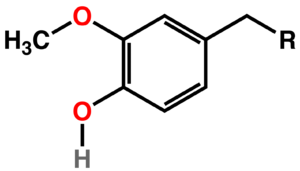
Vanillyl
Encyclopedia

Organic chemistry
Organic chemistry is a subdiscipline within chemistry involving the scientific study of the structure, properties, composition, reactions, and preparation of carbon-based compounds, hydrocarbons, and their derivatives...
, vanillyl (also known as vanilloyl) is a functional group
Functional group
In organic chemistry, functional groups are specific groups of atoms within molecules that are responsible for the characteristic chemical reactions of those molecules. The same functional group will undergo the same or similar chemical reaction regardless of the size of the molecule it is a part of...
. Compounds containing a vanillyl group are called vanilloids, and include vanillin
Vanillin
Vanillin is a phenolic aldehyde, an organic compound with the molecular formula C8H8O3. Its functional groups include aldehyde, ether, and phenol. It is the primary component of the extract of the vanilla bean. It is also found in Leptotes bicolor, roasted coffee and the Chinese red pine...
, vanillic acid
Vanillic acid
Vanillic acid is a dihydroxybenzoic acid derivative used as a flavoring agent. It is an oxidized form of vanillin...
, capsaicin
Capsaicin
Capsaicin 2CHCH=CH4CONHCH2C6H3-4--3- ) is the active component of chili peppers, which are plants belonging to the genus Capsicum. It is an irritant for mammals, including humans, and produces a sensation of burning in any tissue with which it comes into contact...
and VMA.
A number of vanilloids, most notably capsaicin, bind to the Transient receptor potential vanilloid type 1
TRPV1
The transient receptor potential cation channel subfamily V member 1 ', also known as the capsaicin receptor and the vanilloid receptor 1, is a protein that, in humans, is encoded by the TRPV1 gene...
(TRPV1) receptor, an ion channel
Ion channel
Ion channels are pore-forming proteins that help establish and control the small voltage gradient across the plasma membrane of cells by allowing the flow of ions down their electrochemical gradient. They are present in the membranes that surround all biological cells...
which naturally responds to noxious stimuli such as high temperatures and acidic pH
PH
In chemistry, pH is a measure of the acidity or basicity of an aqueous solution. Pure water is said to be neutral, with a pH close to 7.0 at . Solutions with a pH less than 7 are said to be acidic and solutions with a pH greater than 7 are basic or alkaline...
. This action is responsible for the burning sensation experienced after eating spicy peppers
Capsicum
Capsicum is a genus of flowering plants in the nightshade family, Solanaceae. Its species are native to the Americas where they have been cultivated for thousands of years, but they are now also cultivated worldwide, used as spices, vegetables, and medicines - and have become are a key element in...
.
Outside of the food industry, vanilloids such as nonivamide
Nonivamide
Nonivamide, also called pelargonic acid vanillylamide or PAVA, is an organic compound and a capsaicinoid. It is an amide of pelargonic acid and vanillyl amine. It is present in chili peppers, but is commonly manufactured synthetically...
are used commercially in pepper spray
Pepper spray
Pepper spray, also known as OC spray , OC gas, and capsicum spray, is a lachrymatory agent that is used in riot control, crowd control and personal self-defense, including defense against dogs and bears...
formulations.
Other vanilloids which act at TRPV1 include resiniferatoxin
Resiniferatoxin
Resiniferatoxin is a naturally occurring, ultrapotent capsaicin analog that activates the vanilloid receptor in a subpopulation of primary afferent sensory neurons involved in nociception...
and olvanil.

